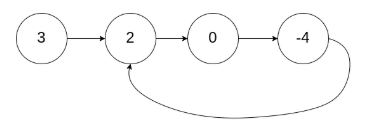给定一个链表,返回链表开始入环的第一个节点。 如果链表无环,则返回 null。
为了表示给定链表中的环,我们使用整数 pos 来表示链表尾连接到链表中的位置(索引从 0 开始)。 如果 pos 是 -1,则在该链表中没有环。
说明:不允许修改给定的链表。
示例 1:
输入:head = [3,2,0,-4], pos = 1
输出:tail connects to node index 1
解释:链表中有一个环,其尾部连接到第二个节点。

示例 2:
输入:head = [1,2], pos = 0
输出:tail connects to node index 0
解释:链表中有一个环,其尾部连接到第一个节点。

示例 3:
输入:head = [1], pos = -1
输出:no cycle
解释:链表中没有环。

思路:
慢指针一次一步,快指针一次两步。能相遇就是有环,反之没有环。
让一个指针从头走,另一个从相遇点开始走,然后再次相遇的地方就是入环点,不明白的画一画,想一想操场跑步就明白了。
/*** Definition for singly-linked list.* class ListNode {* int val;* ListNode next;* ListNode(int x) {* val = x;* next = null;* }* }*/
public class Solution {private ListNode getIntersect(ListNode head) {ListNode tortoise = head;ListNode hare = head;while (hare != null && hare.next != null) {tortoise = tortoise.next;hare = hare.next.next;if (tortoise == hare) {return tortoise;}}return null;
}public ListNode detectCycle(ListNode head) {if (head == null) {return null;}ListNode intersect = getIntersect(head);if (intersect == null) return null;ListNode ptr1 = head;ListNode ptr2 = intersect;while (ptr1 != ptr2) {ptr1 = ptr1.next;ptr2 = ptr2.next;}return ptr1;}
}
-VectorNet- Encoding HD Maps and Agent Dynamics from Vectorized Representation)


跨域解决方法)
-逻辑回归LR、POLY2、FM、FFM)



-Learning Lane Graph Representations for Motion Forecasting)

-Make编译,Configure)

-Ubuntu装系统)
)

-Ubuntu装机后的基础应用)

--Chapter2(上)-概率分布-二元变量、多项式变量、高斯分布、指数族分布)

